

benaki museum
Christina Balli (pireaus) |
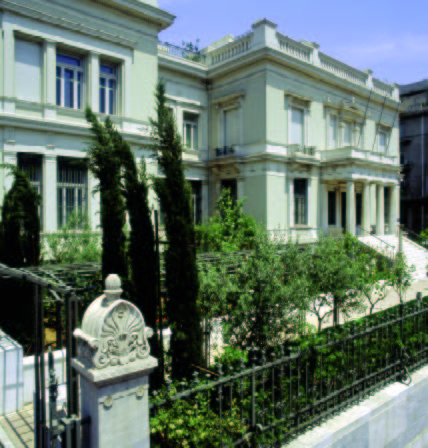 |
|
|
The Museum was founded in 1930 by Antonis Benakis who donated his private
collections to the Greek State, converting his paternal home -one of the
outstanding neoclassical buildings in the centre of Athens- into the first
private museum in Greece. The public responded to Benaki’s initiative and the Museum’s treasures quickly proliferated, thanks to benefactors and donors. Exhibits span the Neolithic Age to the twentieth century; many of them are masterpieces of Greek art and significant testimonies for Greek history: from Antiquity and the Roman era to the Byzantine Age, from the Ottoman occupation to the outbreak of the Greek Independence War, from the formation of the Modern Greek State until the Asia Minor Catastrophe. Moreover, the Museum has a rich activity of temporary exhibitions, educational programmes and diverse cultural events, thus enriching the visitor’s image of Hellenic civilization. In 2004 the Benaki Museum inaugurated two new buildings: the Museum of Islamic Art, in the Kerameikos area, with an important collection covering 13 centuries of creativity; and the Cultural Centre at Pireos street, housed in an industrial building which has been transformed into a modern space designed to accommodate multiple events. |
|
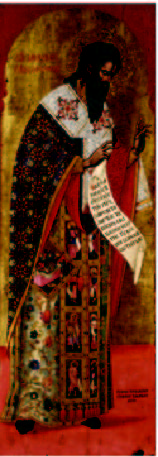 |
Stefanos
Tzangaloras, |
Lateral Sanctuary Door with St James the Brother of the Lord. |
| Christina
Balli Born in Pireaus, 1975 She lives and works in Athens and Pireaus |
No title, 2004 |
Christina Balli, graduate at the Fine Art Academy
of Athens, presents her work which is the fruit of a fertile, systematic,
responsible and creative artistic research. With observance and precision
she composes bold surfaces with a contemporary, coloured and melancholic
poetry. |
|
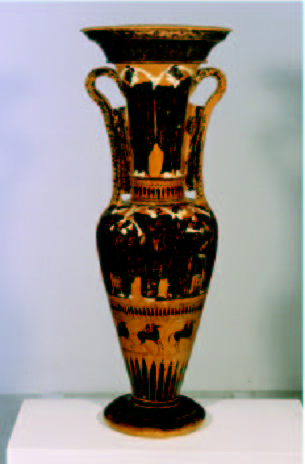 |
Attic black-figure loutrophoros, 500-490 BC |
Attic black-figure loutrophoros with depiction of the prothesis of the dead, on the body, and mourning women, on the neck. Loutrophoroi were used for the nuptial bath and as funerary vases on graves of unmarried youths. Mourning scenes on the body and neck of the vessel illustrate best the dominant role of woman in this funerary ritual. We should assume that this ritual essentially took place with the whole community present. 500-490 BC. |
Annalisa
Furnari Loredana
Longo Giuliana
Lo Porto |
(1)3
unoallaterza,un 2004 |
Three women converge towards the center of a light
cone and kneel. A man braids their long hair. Ambra Stazzone |
|
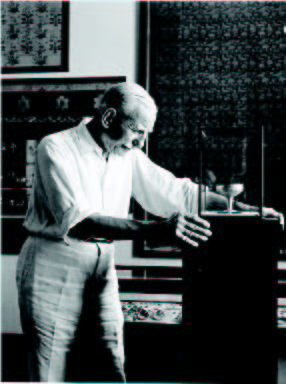
|
Antonis
Benakis (1873-1954) in the Museum |
Scion
of a historic family of the Greek diaspora, Antonis Benakis was born in
Alexandria in 1873 and was brought up in the still flourishing tradition
of good works. At an early age, he began to display an interest in collecting,
especially towards eastern art and paintings. Simultaneously there ripened
in his mind the idea that he might eventually make a donation of his collections,
an idea that led in 1926 to his making Athens his permanent home. Antonis
Benakis made a determinate |
| Antti
Laitinen Born in 1975 He lives and performs in Finland and in Russia www.kuva.fi/~anttilai |
Benaki's
portrait 2004 |
Physical exertion and seeking its limits is central to the art of Antti Laitinen. In the Metsän poika (Son of the Woods) series of photographs, the artist portrays his own survival outdoors, without shelter food or clothing. In the photographs of Hikityö (Sweaty Labor) the artist runs in a treadwheel of his own making, after which he presses his sweaty body on photographic paper. At his graduation exhibition for the Academy of Fine Arts in Helsinki, Laitinen displayed three stones resembling each other that were placed on pedestals. He had dug up one of the stones in seven minutes, the other in seven hours and the third one in seven days. In Athens, Laitinen caries out a project in which he will run an orienteering course following the outlines of a photograph printed on a map. The route run by the artist will be documented by GPS and marked on paper. Laitinen makes art in which the important consideration is a certain process and its systematic nature. The accomplishment can be seen as a ritual, a means of spiritual cleansing and renewal. He does not produce art, but instead engages himself in hard work for his art. Henna Paunu |
|
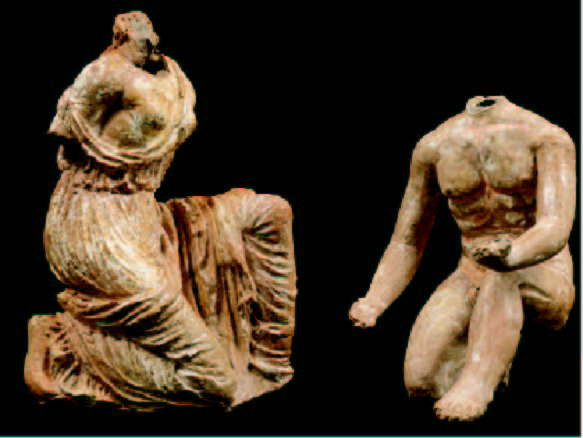
|
Terracotta statuettes of a Nymph and a Satyr, 3rd-c BC |
Terracotta statuettes of a Nymph and a Satyr, parts of a rare and originally integrated 3rd-c. BC composition. Despite the traumatic survival of the two figures and the loss of the colours with which they were originally painted the workmanship is exceptional. Donation by Peggy Zoumboulakis. |
| Fabio
Lattanzi Antinori Born in Rome, 1975 He lives and performs in Rome www.toxicdesignstudio.com |
Uno,
2004 |
Fabio Lattanzi Antinori conceived “Documenta” with an aim between function and form: resuming an emotional reading of the individuals by translating their inner universe into images. The project seeks for some suitably located subjects within the selected context and displays the least visible part of their bodies: an ideal identity card which narrates intimate corners of life through some technological instruments and a pictorially-rooted figurative glance. The subjects are scanned, dissected in a sort of technological surgery and then presented on prints with the addition of writings and of a video support. Following the same principle, the artist connects himself to Benaki, by “reading” sculptures and people of the area in a motivated identity between Mediterranean cultures and evidences of future. Gianluca Marziani |
|